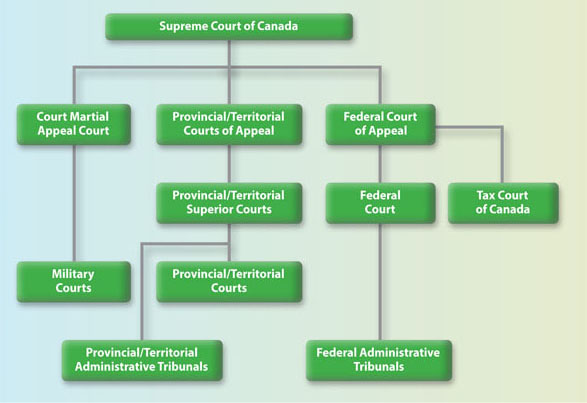Many Of The Special Courts Mimic What Court's Makeup?
The judicial structure
How the courts are organized
The federal and provincial and territorial governments are all responsible for the judicial system in Canada.
Only the federal government tin appoint and pay judges of the superior, or upper-level, courts in the provinces. Parliament can also establish a general courtroom of entreatment and other courts. It has created the Supreme Courtroom of Canada, the Federal Courtroom and the Federal Court of Appeal, equally well as the Taxation Court.
Parliament also has exclusive say-so over the procedure in courts that endeavour criminal cases. Federal authority for criminal law and procedure ensures fair and consistent treatment of criminal behaviour across the land.
The provinces administer justice in their jurisdictions. This includes organizing and maintaining the civil and criminal provincial courts and ceremonious procedure in those courts.
Outline of Canada's Court System

Outline of Canada's Court System – Text version
This chart provides an overview of the hierarchy of Canada's Court System. It is bundled as follows:
Courts
- Supreme Court of Canada
- Courtroom Martial Entreatment Courtroom
- Military Courts
- Provincial/Territorial Courts of Appeals
- Provincial/Territorial Superior Courts
- Provincial/Territorial Courts
- Provincial/Territorial Superior Courts
- Federal Court of Appeal
- Federal Court
- Tax Court of Canada
- Courtroom Martial Entreatment Courtroom
Administrative Boards and Tribunals
- Provincial/Territorial Administrative Tribunals
- Federal Authoritative Tribunals
What practice the federal courts do?
The Supreme Court of Canada is Canada's final court of appeal. Its 9 judges represent the four major regions of the country. 3 of them must be from Quebec, to adequately represent the civil law system.
The Supreme Courtroom has ii main functions.
- It hears appeals from decisions of the entreatment courts in all the provinces and territories, equally well every bit from the Federal Courtroom of Appeal. Supreme Court judgments are final.
- It decides important questions nigh the Constitution and controversial or complicated areas of individual and public law. The government tin can besides ask the Supreme Courtroom for its opinion on of import legal questions.
The federal government also established the Federal Court, the Tax Courtroom and the Federal Court of Appeal.
The Federal Courtroom specializes in areas such equally intellectual belongings, maritime law, federal–provincial disputes, and civil cases related to terrorism.
The Taxation Court specializes in hearing appeals from taxation assessments.
The Federal Courtroom of Appeal reviews the decisions of both these courts. In fact, it is the highest court of the land for nearly 95 percent of all cases.
Provincial and territorial level courts
The court organization is roughly the same beyond Canada. Except for Nunavut, each province has three levels: provincial and territorial, or lower, courts; superior courts; and entreatment courts. The Nunavut Court of Justice has a single-level trial court.
Provincial and territorial courts
Provincial courts endeavor nearly criminal offences, coin matters and family matters. In individual-law cases involving breach of contract or other claims of impairment, the courts employ common-constabulary principles in ix provinces and the territories. In Quebec, courts apply the Quebec Civil Code.
Provincial courts may also include specialized courts, such every bit youth courts, family unit courts, and modest claims courts. Each provincial government appoints the judges for its own courts.
Superior courts
Superior courts are the highest level of courts in a province or territory. They bargain with the most serious criminal and ceremonious cases and accept the power to review the decisions of the provincial and territorial courts.
Superior courts are divided into two levels: trial level and entreatment level.
- The trial-level courts hear civil and criminal cases. They may be chosen the Supreme Courtroom, the Court of Queen'southward Demote, or the Superior Court of Justice.
- The appeal-level courts, or Courts of Appeal, hear civil and criminal appeals from the superior trial courts listed above.
Although the provinces and territories administrate superior courts, the federal authorities appoints and pays the judges.
Administrative boards and tribunals
There are other kinds of disputes that practice not demand to be dealt with in the courts. Different kinds of authoritative tribunals and boards bargain with disputes over the interpretation and application of laws and regulations, such every bit entitlement to employment insurance or disability benefits, refugee claims, and human rights.
Administrative tribunals are less formal than courts and are not part of the court organisation. However, they play an essential role in resolving disputes in Canadian society. Decisions of administrative tribunals may be reviewed in courtroom to ensure that tribunals act fairly and according to the police.
Many Of The Special Courts Mimic What Court's Makeup?,
Source: https://www.justice.gc.ca/eng/csj-sjc/just/07.html
Posted by: chamblisswaregs.blogspot.com


0 Response to "Many Of The Special Courts Mimic What Court's Makeup?"
Post a Comment